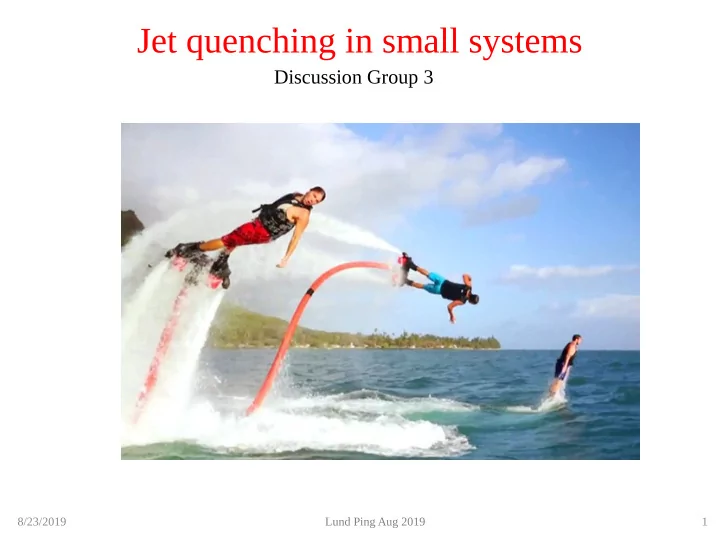

Jet quenching in small systems Discussion Group 3 8/23/2019 Lund Ping Aug 2019 1
Reminder of issues: poster I 8/23/2019 Lund Ping Aug 2019 2
Reminder of issues: poster II • Inclusive and coincidence measurements do not give consistent picture of quenching • Coincidence preferred due to issues with <TpA> • Is 400 MeV (90% CL) a significant constraint? 8/23/2019 Lund Ping Aug 2019 3
What is a small system? Is there a continuum pp -> pA -> AA? • pp -> pA : increase density but not size • pA -> AA : increase both size and density cannot turn effects "on and off” : physics lies in how things change • systematic check: regions of common EA in different systems Scaling quantities: • Large systems: • Small systems Other observables: forward ET 8/23/2019 Lund Ping Aug 2019 4
What are the theoretical expectations for jet quenching in small systems? No detailed calculations to date, only parametric projections: • scaling by multiplicity ; assumes continuum large AA →small systems (a) BDMPS approach: • soft induced radiation occurs early • Signatures: soft, large-angle radiation; softening of fragmentation at low-z Relative effects largest for lowest p T • jet (b) Monte Carlo approach (e.g. JEWEL): • Small systems do not present any special barrier: thin medium can be accommodated • needs a medium: hydro, transport; both are discretized • Model of medium needs to be calibrated/tuned on soft observables (c) Angantyr: jet-medium interaction via shoving mechanism • No external model of medium • Deep connection to flow: same physical mechanism 8/23/2019 Lund Ping Aug 2019 5
What generates high multiplicity in small systems? How can data check models? EA bias in p+Pb: how does high-Q^2 process in central region change the distribution? High p T track in central barrel Forward multiplicity l a v r e t n \ i \ p T n i ” k c a r t r ) e c g / V g i e r G T “ 7 < p T < 6 . g Mechanisms: . e ( • Ncoll bias (geometry) • ”peripheral” QCD correlations (color flow) ”central” p+p also interesting: TBD 8/23/2019 Lund Ping Aug 2019 6
p+Pb hard process bias: Angantyr vs. ALICE data Excellent agreement of model with data Use model to explore the nature of the bias. Possible contributions: • Ncoll weighting (geometric bias) • Color correlations (strings connect central and forward) • Energy-momentum convservation (unlikely at LHC but let’s see…) 8/23/2019 Lund Ping Aug 2019 7
Angantyr: bias in impact parameter distribution due to central hard process Forward mult: strong impact param bias Central hard process: no additional bias (!) →forward/central are largely decoupled 8/23/2019 Lund Ping Aug 2019 8
New prediction: forward mult bias in pp p+Pb: model and data agree p+p: not yet measured! Predict much larger bias in pp than p+Pb • what is underlying mechanism? This prediction is a great outcome of this workshop 8/23/2019 Lund Ping Aug 2019 9
Forward neutron tagging in d+Au @ RHIC Additional test of control over geometry in p/d+A • Use neutron in ZDC and Hulthen wavefn of the deuteron to tag “peripheral” p+Au events • Unfortunately not achievable at LHC due to injection system STAR 2003 8/23/2019 Lund Ping Aug 2019 10
Summary: jet quenching in small systems Effects expected to be small • Correlation of EA and geometry is challenging: inclusive suppression (RAA) will always have limited systematic precision • Most precise measurements utilize coincidences (and potentially substructure) • Are current limits significant? Need calculations Status of calculations: • String approach: First results from Angantyr • MC: JEWEL in progress, needs models of medium; no known show-stoppers What do we talk about when we talk about high multiplicity in small systems? • ⟺ Are there correlations forward mult central hard? Angantyr: No! • This is an extremely important (and new) result: justifies usage for forward mult as independent characterization of events • predictions for pp… We now have a clear path forward to explore jet quenching in small systems in both experiment and theory, and know how to compare them 8/23/2019 Lund Ping Aug 2019 11
Recommend
More recommend